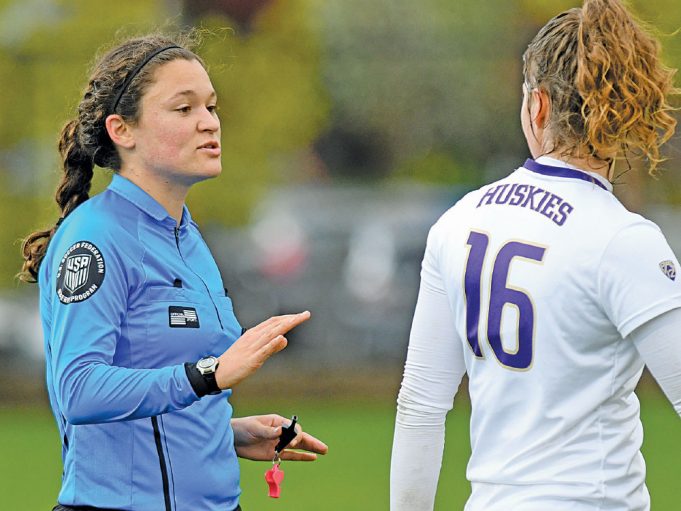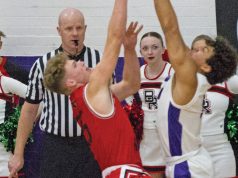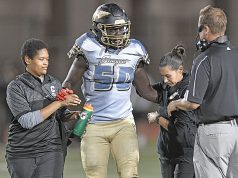Warnings come in a variety of forms. There’s “the look,” “the stop sign” and “the quiet word,” to name a few. Each can be appropriate in certain situations. Officials must know when a warning is appropriate based on what is happening in the game at the time. It might be the right action in response to questioning of a call. A warning can be issued as a form of preventive officiating. In certain sports, the rules mandate warnings or cautions in response to acts or violations.
This is not to say warnings are a cure-all or a substitute for enforcement. Warnings are not appropriate when basic rules are being broken during a game. Officials must manage the game and know when to get rid of the warnings and replace them with penalties, technical fouls, bench restrictions, cards or ejections. And without question, the old “One more word and you’re outta here” warning — which is more of a threat, anyway — is to be avoided at all costs.
Still and all, a warning can be an effective technique in game control. Here are some tips on how to warn various participants.
Coaches
Because of the nature of their job, more than a few head coaches are going to create conflict for officials. Use preventive officiating whenever you can and tolerate a bit more from them than you would other participants. Use the full range of warnings for head coaches, from a silent look that says, “I’ve heard you,” to a more formal verbal warning that you’ve heard enough (meaning they’ve used up their leash and the next time you deal with them it will be with a penalty).
Assistant coaches, reserve players and other personnel on the bench such as team managers, trainers, etc., should be afforded much less tolerance. When there’s a problem with someone on the bench, go directly to the head coach and tell the coach about the problem. More often than not, the coach will fully support you. Almost no coach will tolerate a mouthy benchwarmer who caused the team a penalty.
Players
Constant communication is the key to preventive officiating with players who are in the game. Many times upset players only want you to listen to them. Acknowledge their concern and often that will mollify them.
Reckless or rough play gets no warning — penalize immediately. But if the overexuberance hasn’t reached that level, serving notice lets the player know an authority figure is paying attention.
Fans
Booing the officials is as old as sports themselves. Officials can’t be so thin-skinned as to respond or be bothered by it. Standing in front of the rowdies and wagging a warning finger will only inflame the situation. If it goes beyond razzing, get the game manager involved. Profanity directed at game personnel, tossing of material onto the playing surface, fights, threating acts or gestures must be dealt with by game management.
When to warn
As noted, warnings can be issued for a number of reasons. In football, a player who would have been flagged for holding had the play not gone to another area of the field can be alerted to block rather than grab. Baseball umpires often have a catcher or infielder tell the pitcher to avoid a balk by taking a longer pause in the set position with runners on base. Carelessly tossed bats usually bring a warning upon first offense.
When a player’s overaggressive play is threatening the orderly progress of a game that has free substitution, an official can suggest the coach have the player taken out of the game temporarily to simmer down. Note that is not an order, merely a suggestion. The coach can reject your suggestion and run the risk of the player being penalized or ejected, or accept the advice.
When it comes to warnings, a look can be as good as the spoken word. Often fewer words get the message across than a longer oration. Assuming the rulebook doesn’t mandate use of the actual phrase, “I’m warning you” or “That’s a warning” needn’t be the best thing to say.
End a verbal altercation with, “That’s enough.” You may want to supplement the warning with the “stop sign,” an upraised hand that indicates the conversation is at an end. “Let’s play” is a good way to move forward and get the game going again. By telling the participants to resume action by putting the ball into play, you can end further dialogue and help let everyone move on.
An effective official is able to deal professionally with coaches, even in the most heated situations. Voice control is a must; maintain an even, yet confident tone. An official who exercises good voice control will slowly bring an excited coach down to a manageable emotional level. Be pleasant, yet firm when necessary, in explaining calls or relating information to coaches.
One way to quickly implement that technique is to ask the coach a question. For instance, an official can ask a coach, “What did you see?” That triggers the listening process as the coach relates his or her opinion and, in the process, feels the satisfaction of having your attention and getting something off the chest. For continuous-action sports, there may be no time to stop and talk directly to a coach. In those circumstances, it’s a good idea to catch the coach’s eye as you’re going past and give a wave or a thumbs up of recognition.
What's Your Call? Leave a Comment:
Note: This article is archival in nature. Rules, interpretations, mechanics, philosophies and other information may or may not be correct for the current year.
This article is the copyright of ©Referee Enterprises, Inc., and may not be republished in whole or in part online, in print or in any capacity without expressed written permission from Referee. The article is made available for educational use by individuals.
















